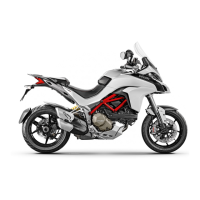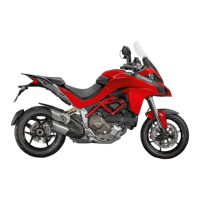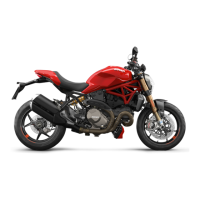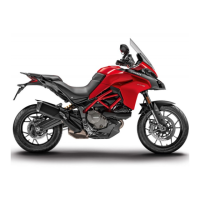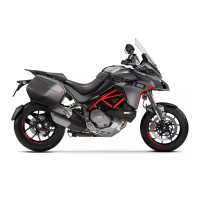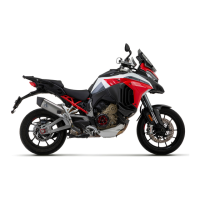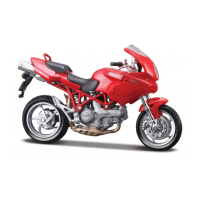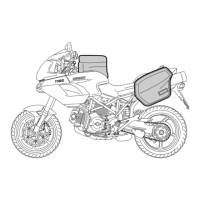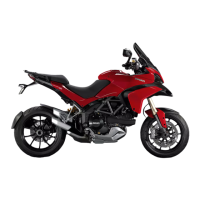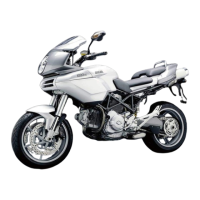Do you have a question about the Ducati Multistradia 1200S ABS Touring and is the answer not in the manual?
Explains the meaning of symbols used throughout the manual.
Provides general warranty details and advice.
Provides crucial safety advice and warnings for riding the motorcycle.
Details on carrying maximum load and speed limits with luggage.
Information on frame and engine identification numbers.
General description of the motorcycle's instrument panel layout.
Explanation of various functions displayed on the LCD screen.
Details on indicators for speed, RPM, gear, and clock.
Information on alarms, signals, and instrument panel error diagnostics.
Information on maintenance indicator and range reached for service.
Essential checks to perform before riding the motorcycle.
Procedure for checking and topping up the engine oil level.
Procedure for checking and adjusting drive chain tension.
How to select and customize riding styles and vehicle setups.
Procedure for changing the motorcycle's riding style.
Customizes the intervention level of Ducati Traction Control (DTC).
Customizes engine power and output for different riding styles.
Explanation of the antitheft electronic system.
Instructions for replacing the battery in the active key.
Procedure to temporarily start the motorcycle if the HF system fails.
Procedure for changing the four-number PIN CODE.
Management of headlight switching and turn signals.
How to operate the hands-free system Key-On and Key-Off.
Adjusting gearchange, rear brake pedals, and clutch lever.
Procedure for operating the seat lock and removing seats.
Information on using the side stand and centre stand.
Instructions for adjusting front fork and rear shock absorber.
Guidance for the initial period of motorcycle use.
Instructions for starting and stopping the motorcycle engine.
Procedures for starting to move and stopping the motorcycle.
Information on the Anti-Lock Brake System and its use.
Procedure for checking and topping up the coolant level.
Checking brake and clutch fluid levels and importance of correct levels.
How to inspect brake pads for wear and when to replace them.
Instructions and warnings for charging the motorcycle battery.
Guidance on checking, cleaning, and replacing spark plugs.
Details on overall dimensions, weights, and capacities.
Specifications for the engine and its timing system.
Details on the front and rear brake systems.
Information on the transmission and approved gear ratios.
Information on front and rear fuse box locations and their contents.
Locating and identifying the main fuse for the electrical system.
Key to understanding wire colours used in electrical diagrams.
Procedure for reporting vehicle safety defects to NHTSA.
Details on noise emission warranty and exhaust system.
General safety points for everyday motorcycle use.
Information on how to locate and understand the VIN.
Your warranty rights and obligations for emission control systems.
Details on the duration and scope of the manufacturer's warranty.
Conditions and exclusions that limit the emission control system warranty.
| Transmission | 6-speed |
|---|---|
| Power | 110.3 kW (150 hp) @ 9, 250 rpm |
| Torque | 91 lb-ft (123 Nm) @ 7500 rpm |
| Fuel injection | Electronic fuel injection |
| Frame | Tubular steel trellis |
| Front suspension | 48 mm |
| Front brake | 2 x 320 mm semi-floating discs, radially mounted Brembo |
| Rear brake | 245 mm disc, 2-piston caliper, ABS |
| Front tire | 120/70 ZR17 |
| Rear tire | 190/55 ZR17 |
| Wheelbase | 1, 530 mm (60.2 in) |
| Fuel tank capacity | 20 l (5.3 US gal) |
